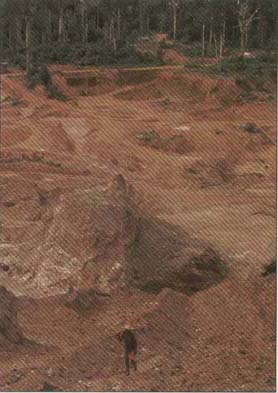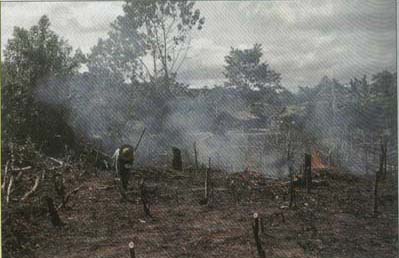Case study of shifting cultivation
THE AMAZON BASIN IN BARZIL, SOUTH AFRICA
[Source: Geography an Integrated Approach 3rd edtion P.480]
With the help of stone and machetes, the Amerindians clear a small area of about 1 hectare in the forest .Sometimes the largest trees are left standing to protect young crops from the sun's heat and the heavy rain;so also are those which provide food, such as the banana and kola nut. The buttress roots of the giant trees are left. After being allowed to dry the felled trees and undergrowth are burnt¡Xhence the alternative name of 'Slash and burn' cultivation.While burning has the advantage od removing weeds and providing ash for use as a fertiliser, it has the disadvantage of destroying useful organic material and bacteria. The main crop, manioc, is planted along with yams(which need a richer soil), pumpkins, bean, tobacco and coca. The Amerindian diet is supplemented by hunting, mainly for tapirs and monkeys, fishing and collecying fruit.

With the help of stone and machetes, the Amerindians clear a small area of about 1 hectare in the forest .Sometimes the largest trees are left standing to protect young crops from the sun's heat and the heavy rain;so also are those which provide food, such as the banana and kola nut. The buttress roots of the giant trees are left. After being allowed to dry the felled trees and undergrowth are burnt¡Xhence the alternative name of 'Slash and burn' cultivation.While burning has the advantage od removing weeds and providing ash for use as a fertiliser, it has the disadvantage of destroying useful organic material and bacteria. The main crop, manioc, is planted along with yams(which need a richer soil), pumpkins, bean, tobacco and coca. The Amerindian diet is supplemented by hunting, mainly for tapirs and monkeys, fishing and collecying fruit.

The productivity of the rainforest depends upon the rapid and unbroken recycling of nutrients. Once the forest has been cleared, the nurient cycle is broken. The heavy, afternoon, convectional rainstorms hit the unprotected earth causing erosion and leaching. With the source of humus removed, and in the absence of fertiliser and animal manure, the ferralitic soils rapidly lose their fertility. Within 4 or 5 years, the decline in crop yield and the re-infestation of the area by weeds force the tribe to shift to another part of the forest. Although shifting cultivation appears to be a wasteful use of land, it has no long-term adverse effect upon the environment as, in most places, humus can built up sufficiently to allow the land to be re-used within 25 years if necessary.
The traditional Amerindian way of life is being threatened by the destruction of the rainforest. As land is being cleard for highways, cattle ranches, commercial timber, hydro-electric schemes, reservoirs and mineral exploitation, the Amerindians are pushed further into the forest or forced to live on reservations. Of the estimated 6 million Amerindians living in the Amazon rainforest when the European colonists arrived, only about 4 per cent remain today as a result of illness caught frim and death inflicted by the invaders.Recent government policy of encouraging the in-migration of landless farmers from other parts of the country, together with the development of extensive commercial cattle ranching, has meant that sedentary farming is rapidly replacing shifting cultivation. After just a few years, as should have been forseen, large tracts of some cattle ranches and many individual farms have already been abandoned as their soils have become infertile and eroded.